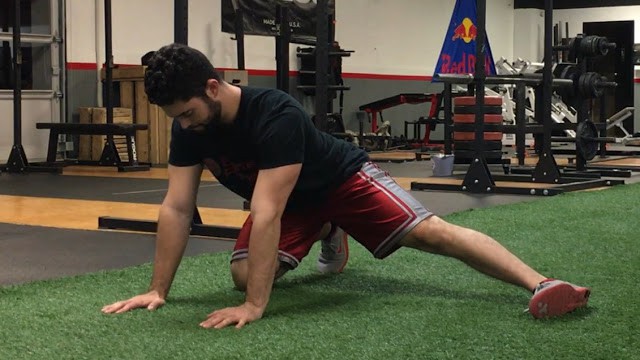People frequently say they are not “mobile” enough to squat to depth. As a result, they stop squatting and begin haphazardly and inefficiently focusing on mobility work.
Here’s the truth. With proper coaching, the vast majority of healthy people CAN squat to depth without ANY mobility work. Even in those who cannot, provided there is no pain/pinching, slowly loading the squat is usually all you need!
The question is this. What do we do for the people who DO experience pain with the squat? This is where the mobility work comes into play.
For mobility work to be effective, it must be INTELLIGENTLY and SPECIFICALLY prescribed and immediately followed up with some form of a loaded squat variation to promote true structural change.
The three biggest areas I see that commonly restrict squat depth and lead to possible pain are:
- Hip internal/external rotation
- Adductor tightness
- Ankle dorsiflexion (DF)
Bench Hip Internal Rotation Mobilization
Lack of hip internal rotation (IR) can surely limit squat depth and also be associated with anterior hip pain. If you’re someone who keeps repeatedly “shoving” your knees out into more and more external rotation (ER) and still have limited depth and pain, it’s time to start going the other way.
For this one. we want to place the hip in a position of IR and then slowly and repeatedly rock back until a stretch is felt deep in the hip capsule. If you feel this one pinching in the front of the hip, work in a shorter ROM. We don’t want to work through pinches.
Standing Lunge on Table
Some people experience perceived tightness at the bottom of the squat around their lower glute/upper hamstrings area. The standing lunge on a table is perfect for that.
Place your leg up on a high table, keep a neutral spine to avoid a posterior pelvic tilt and sink DOWN into deep hip flexion. This helps to temporary reduce perceived tightness at the bottom of the squat.
Kneeling Hip Adductor Mobilization
Tight adductors can be a nasty bugger, especially for those who squat low-bar and a wider stance. If you don’t have adequate hip adductor mobility, the hips can go into excessive IR and the knees into excessive valgus, two things we don’t want during a loaded squat.
For this drill, I want you to keep a neutral spine and slowly move into both hip flexion and extension. You should feel a comfortable, pain-free stretch at the end of both movements.
Repeated Ankle Plantar Flexion
Ankle dorsiflexion (DF) is an essential component for successful squatting mechanics, especially those who train the Olympic lifts. While I am a fan of ankle DF mobilizations, there are enough of those floating around the internet and chances are you’ve probably tried most of them anyways…how’s that going for you?
If you still have limited ankle DF even after trying every DF mobilization known to mankind, maybe it’s time to give your nervous system the novel input it needs by doing repeated PLANTARFLEXION and great toe flexion. This can help decrease the neural lock occurring in your ankle and lead to a transient increase in DF. Solidify this temporary increase in mobility by loading the squat pattern immediately after.
Paused Squats with IR/ER
Whether your limited squat depth is a mobility or motor control issue, if you want to be better in the bottom position, it’s time to spend more time down there. For this drill, squat down to just above your current depth, in a pain-free position and slowly move your hip into ER and IR.
This is a great way to train hip mobility in the place it matters most. If you get pinching in the hip with this one, you’ve gone down too far. It’s important that this is pain-free!
Conclusion
As stated before, the vast majority of people can indeed squat to depth with proper coaching. For those of you who have already optimized your stance and still have pain or limitations, give some of these drills a try.Do they cause permanent change? Probably not. That would be pretty scary if one of these minimally loaded drills had the capability to cause permanent adaptation. They simply promote a temporary increase in mobility and decrease in pain. It’s YOUR JOB to solidify these improvements by getting under that loaded barbell and squatting HEAVY in your newly acquired pain-free range!

